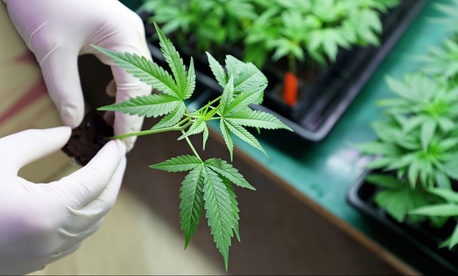Growing cannabis can seem like a daunting task, but with a bit of practice and the right guidelines, you’ll be harvesting beautiful buds in no time.
Click here to see the Space Bucket method for saving $$$ growing indoors.
Light
The cannabis plant needs much more light than most other plants. Since you’ll be growing indoors, you’ll need to carefully choose your light source. If you are on a limited budget, compact fluorescent light bulbs can be a good start. The downside with compact bulbs is they are weaker than dedicated growing lights. If you can afford LED growing lights, you may find your plants growing quicker and more robust than if you use fluorescent bulbs. Once the plants have fully grown, they’ll be ready to begin flowering. At this point, you’ll want to keep them on a strict schedule of 12 hours of light and 12 hours of darkness to induce budding. Be patient because most plants need about three months from the time they flower until they can be harvested.
Check out our tips on choosing the best lights for growing indoors.
Growing Container
As a beginner, you may want to consider growing your first plants in a smaller pot. Your yield will not be as large in a small pot, but you will gain valuable lessons to use on your next round. The most important thing in selecting a pot is the drainage holes at the bottom. You don’t want to drown your plants. A fabric pot is also an excellent choice because it allows oxygen to circulate freely. Keep in mind you will need to water more often with a fabric pot because the additional air tends to dry plants out. At some point, you’ll want to transplant your buds into a bigger pot. More room encourages root growth and can lead to healthier plants. When transplanting, you don’t want to pull the whole plant out, which will disrupt the roots. Instead, try cutting away your container and gently moving the plant into a bigger pot. A good rule of thumb is to move your plants each time they double in size.
Temperature
When it comes to temperature, marijuana plants can be finicky. Low temperatures can suffocate a plant because it reduces evaporation through the leaves. High temperatures are also problematic because they hinder the growth and potency of your plants. In general, marijuana plants grow best 68 and 77 degrees Fahrenheit when your lights are on. Drop the temperature to between 62 and 72 degrees Fahrenheit when the lights are off. Consider investing in a thermostat and a small space heater to keep your plants at the right temperatures.
Nutrients
It is important when choosing a soil to keep in mind your skill level and knowledge. Organic soil can be great for beginners, but it can hinder growth and produce smaller harvests. Synthetic nutrients such as clay pebbles and Rockwool will encourage growth, but they require much more care and attention. In addition to soil, you’ll want to use a good pre-mixed fertilizer to ensure your plants are getting all the nutrients they need.
Water
Watering is an important step in the process of growing healthy cannabis. Too much water can drown your plants, while too little will cause them to wither and eventually die. But how do you know when your plants need to be watered? The easiest method is to place your finger in the soil up to the first knuckle. If the soil is dry, it is time to water. You can also lift your pot to gauge if feels too light which means your plants have used all the water. In the beginning stages of growing, you’ll likely be watering 2 to 3 times per week. Once you transplant to a bigger pot, you can usually slow the watering to once or twice per week. Your plants are sufficiently watered when you get a 20% runoff from the drainage outlets.
With a bit of patience and practice, growing cannabis can be a rewarding experience. Make sure to check with your local jurisdiction to ensure you are within your legal boundaries before you begin growing.

